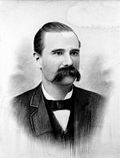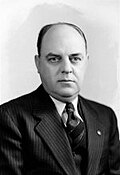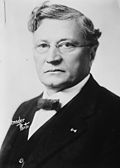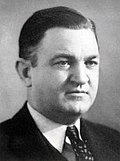Top Qs
Timeline
Chat
Perspective
List of governors of Arkansas
From Wikipedia, the free encyclopedia
Remove ads
The governor of Arkansas is the head of government of the U.S. state of Arkansas. The governor is the head of the executive branch of the Arkansas government and is charged with enforcing state laws. They have the power to either approve or veto bills passed by the Arkansas General Assembly, to convene the legislature, and to grant pardons, except in cases of treason and impeachment.[2]
Remove ads
The state has had 46 elected governors, as well as 11 acting governors who assumed powers and duties following the resignation or death of the governor. Before becoming a state, Arkansas Territory had four governors appointed to it by the president of the United States. Orval Faubus (1955–1967) served the longest term as governor, being elected six times to serve 12 years. Bill Clinton (1979–1981; 1983–1992), elected five times over two distinct terms, fell only one month short of 12 years, and Mike Huckabee (1996–2007) served 10 years for two full four-year terms. The shortest term for an elected governor was the 38 days served by John Sebastian Little before his nervous breakdown; one of the acting successors to his term, Jesse M. Martin, took office only three days before the end of the term, the shortest term overall.
The current governor of Arkansas is Republican Sarah Huckabee Sanders, who was sworn in on January 10, 2023.
Remove ads
List of governors
Summarize
Perspective
Arkansas Territory
Arkansaw Territory (renamed Arkansas Territory, circa 1822)[a] was split from the Missouri Territory on July 4, 1819.[4] As territorial secretary from 1819 to 1829, Robert Crittenden served as acting governor whenever the appointed governor was not in the state. This meant that Crittenden was the first person to perform the duties of governor, since James Miller did not arrive in the territory until nine months after his appointment.[5]
State of Arkansas
Arkansas was admitted to the Union on June 15, 1836.[28] The state seceded on May 6, 1861,[29] and was admitted to the Confederacy on May 18, 1861.[30] When Little Rock, the state capital, was captured on September 10, 1863, the state government relocated to Washington, Arkansas, and a Union government was installed in its place, causing an overlap in the terms of Confederate governor Harris Flanagin and Union governor Isaac Murphy.[31] During the post-war Reconstruction period, it was part of the Fourth Military District. Arkansas was readmitted to the Union on June 22, 1868.[32]
The Arkansas Constitution of 1836 established four-year terms for governors,[33] which was lowered to two years in the 1874, and current, constitution.[34] An amendment in 1984 increased the terms of both governor and lieutenant governor to four years.[35] Governors were originally limited only to serving no more than eight out of every twelve years,[33] but the 1874 constitution removed any term limit. A referendum in 1992 limited governors to two terms.[36][37]
Until 1864, the constitutions provided that, should the office of governor be rendered vacant, the president of the senate would serve as acting governor until such time as a new governor was elected or the disability removed, or the acting governor's senate term expired.[38][39] This led to some situations where the governorship changed hands in quick succession, due to senate terms ending or new senate presidents being elected. For example, after John Sebastian Little resigned in 1907, 3 senate presidents acted as governors before the next elected governor took office. Should the president of the senate be similarly incapacitated, the next in line for the governorship was the speaker of the state house of representatives.[citation needed]
The 1864 constitution created the office of lieutenant governor[40] who would also act as president of the senate,[41] and who would serve as acting governor in case of vacancy.[42] The 1868 constitution maintained the position,[43] but the 1874 constitution removed it and returned to the original line of succession.[44] An amendment to the constitution, passed in 1914 but not recognized until 1925,[45] recreated the office of lieutenant governor, who becomes governor in case of vacancy of the governor's office.[46] The governor and the lieutenant governor are not officially elected on the same ticket.[47]
Arkansas was a strongly Democratic state before the Civil War, electing only candidates from the Democratic party. It elected three Republican governors following Reconstruction, but after the Democratic Party re-established control, 92 years passed before voters chose another Republican.[citation needed]
Remove ads
Timeline

See also
Notes
- The territory was formally organized with the name "Arkansaw", but spellings including "Arkansas" and "Arkansa" remained common until around 1822, when the popularity of the Arkansas Gazette helped standardize the spelling as "Arkansas".[3]
- Miller was nominated, and confirmed by the Senate, on March 3, 1819.[7] However, to avoid the hot southern summer, he delayed his departure from New Hampshire until September, and took an indirect route, finally arriving in the territory on December 26.[8] Robert Crittenden, secretary of the territory, served as acting governor while Miller was delayed.[5] Miller was reconfirmed by the Senate on January 3, 1823.[9]
- Miller resigned citing poor health; at the time of his resignation, he had been absent from the territory for 18 months.[10]
- Izard was nominated on February 22, 1825,[12] confirmed by the Senate on March 3,[13] and took office on May 31.[11] Until he arrived in the territory, Robert Crittenden, secretary of the territory, served as acting governor, though Crittenden himself was out of state when Izard arrived.[14] Izard was reconfirmed by the Senate on January 9, 1828.[15]
- By the time notice of Izard's death reached Washington, D.C., Andrew Jackson had been elected president, and the United States Senate refused to approve John Quincy Adams's choice for governor, Hutchins Gordon Burton.[17] Pope was nominated, and confirmed by the Senate, on March 9, 1829,[18] and took office on May 31.[16][19] Pope was reconfirmed by the Senate on March 23, 1832.[20]
- Fulton was nominated on February 2, 1835,[22] and confirmed by the Senate on February 23,[23] for a term to begin March 9. No contemporary reporting has been found as to when Fulton was sworn in, but one source refers to Pope saying his term would not end until March 28,[24] and another notes Fulton's commission did not arrive until March 24,[25] when he was out of state.[26]
- Fulton served as governor until statehood, when he was elected to the United States Senate.[27]
- According to the numbering generally used, acting governors are not numbered.[48]
- The office of lieutenant governor was created in 1864 and abolished in 1874. It was recreated in 1914, and was not filled until 1927. The amendment to the constitution creating the office was narrowly voted in by the electorate in 1914. The Speaker of the House declared that the measure had lost, because even though it had received the majority of the votes cast for that particular ballot measure, winning 45,567 to 45,206, it had not received the majority of votes cast across the whole election, determined by looking at the question on the ballot with the highest total number of votes for or against. On that ballot, this figure was 135,517 votes, so it was ruled that at least 67,758 votes in favor would have been required for the measure to pass, essentially counting blank votes as votes against. In 1925, it was discovered that a 1910 law amended this requirement such that only a majority of the votes on the specific question was required. Therefore, the 1914 initiative was declared to be valid.[45]
- Yell resigned to successfully run for the United States House of Representatives.[55]
- Drew resigned due to the low salary he received as governor.[65]
- Roane was out of state enough in 1851 that John R. Hampton, president of the Senate, was sworn in as acting governor on June 25, 1851.[71] However, Sobel states Hampton was acting governor in September 1851.[72] No source has been found as to when Roane returned to active work.
- Roane was elected in a special election to fill the remainder of the term vacated by Thomas S. Drew's resignation.[74]
- Conway was out of state in 1857, and president of the Senate John R. Hampton was sworn in as acting governor and served from April 21 to September 14.[72]
- Under the 1836 constitution, governors were not eligible to serve more than eight years in any term of twelve years.[81]
- This term was shortened to two years due to the 1861 constitution moving the election schedule.[89]
- Sobel's entry on Fletcher mixes information with a similarly named man who ran for governor twice; even contemporary sources would confuse the two.[90]
- Some sources state Flanagin left office on April 18, 1864, but that was when Isaac Murphy was sworn in as governor by occupation authorities after winning the 1864 election. Following the evacuation of Little Rock on September 10, 1863, Flanagin was governor in exile at Washington, Arkansas.[95] Flanagin's last official act as governor was to preside over the Arkansas State Military Board during its final meeting at Washington on June 1, 1865;[96] six days after the Trans-Mississippi Department was surrendered to Union authorities at New Orleans.
- Flanagin evacuated Little Rock before it fell to Union forces on September 10, 1863, leading a government in exile at Washington, Arkansas, until the end of the Civil War. Isaac Murphy was sworn in as provisional governor by occupation authorities on January 20, 1864, and elected in his own right under Lincoln's "ten percent plan" (taking office on April 18, 1864), thus causing an overlap in terms.
- On March 14, 1864, a new state constitution was ratified by Union men of Arkansas under President Lincoln's "ten percent plan" in an election supervised by Union occupation authorities; however, it had no effect on Flanagin's government in exile at Washington.[98]
- Clayton resigned, having been elected to the United States Senate. He had delayed his resignation to prevent Lieutenant Governor Johnson from succeeding him; party machinations led to Johnson's resignation and acceptance of the office of secretary of state, so that Hadley, as president pro tempore of the senate, could act as governor for the remainder of the term.[108]
- Baxter was ousted by Joseph Brooks on April 15, 1874, triggering the Brooks–Baxter War. He was reinstated on May 19.[113]
- Baxter received the Democratic nomination, but declined.[114]
- This term was shortened to two years by the 1874 constitution.[34]
- Garland was instead elected to the United States Senate.[121]
- Fishback was out of state for a period in 1893; during that time, Clay Sloan, president of the Senate, acted as governor.[145]
- Fishback instead ran unsuccessfully for the Democratic nomination to the United States Senate.[146]
- Clarke instead ran unsuccessfully for the Democratic nomination to the United States Senate.[152]
- Jones instead ran unsuccessfully for the Democratic nomination for the United States Senate.[156]
- Davis was instead elected to the United States Senate.[160]
- Little resigned after suffering a nervous breakdown soon after taking office.[164]
- President of the Senate Moore acted as governor until the legislature adjourned,[167] at which time a new president pro tempore of the Senate was chosen, Pindall, who acted as governor until his senate term expired.[169] For the remaining three days of the gubernatorial term, Martin, the new president pro tempore of the Senate, acted as governor.[164] Further complicating the situation, Pindall was out of state from May 9 to May 14, 1908, during which time Allen Hamiter, speaker of the House, served as acting governor.[164]
- Robinson resigned, having been elected to the United States Senate.[180]
- Oldham acted as governor for six days before a new president of the senate was elected.[184] The new president, Futrell, acted as governor[186] until Hays was elected in a special election to fill the remainder of the term.[187] Conflict over whether or not Futrell could succeed Oldham as acting governor led to the Arkansas Supreme Court ruling that he could.[188]
- Martineau resigned, having been confirmed to the United States District Court for the Eastern District of Arkansas.[208]
- Adkins instead ran unsuccessfully for the Democratic nomination for the United States Senate.[222]
- Bumpers resigned, having been elected to the United States Senate.[244]
- Pryor resigned, having been elected to the United States Senate.[255]
- Represented the Democratic Party
- Clinton resigned, having been elected President of the United States.[259]
- First term under a 1984 constitutional amendment, which lengthened terms to four years.[35]
- Tucker resigned after being convicted of mail fraud in the Whitewater controversy;[268]
- Represented the Republican Party
- Under a 1993 amendment to the constitution, governors may not serve more than two terms.[272]
- Sanders' term will expire on January 12, 2027.
Remove ads
References
External links
Wikiwand - on
Seamless Wikipedia browsing. On steroids.
Remove ads































































